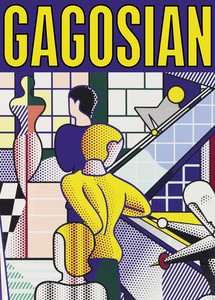
Now available
Gagosian Quarterly Summer 2024
The Summer 2024 issue of Gagosian Quarterly is now available, featuring a detail of Roy Lichtenstein’s Bauhaus Stairway Mural (1989) on the cover.
There it is. I have shown it to you. It has been done. It is being done. And because it can be done, it will be done.
—Kirk Varnedoe, Pictures of Nothing
“The show is over.” Or is it? This exhibition is about abstraction and the end of painting, often proposed but never concluded. Christopher Wool’s statement in paintings, drawings, and billboards, taken from Vasily Rozanov’s nineteenth-century definition of nihilism, contains sufficient irony to suggest that painting itself, the spectacle that surrounds it, and the ultimate questions it poses about life and death, are never quite over.
The negation of painting emerged in Europe after World War II in Francis Picabia’s last paintings, Lucio Fontana’s punctured and slashed Concetto spaziale paintings, Yves Klein’s Fire-Color works, and Piero Manzoni’s quest for neutral materiality in the Achromes. When first exhibited in 1953, Robert Rauschenberg’s White Paintings—monochromatic panel paintings—were unprecedented in their deceptive blankness. These works anticipated diverse interpretations of the neutral picture plane. Gerhard Richter’s paintings of the 1970s, in shades of gray, project a removed, indifferent power. Richard Serra’s Left Corner Horizontal (1977), a dense black expanse of oilstick on linen, produces a physical and spatial void that appears impenetrable.
A shared spirit of negation is evident in the anarchic actions that fueled the urban punk movement, epitomized by Steven Parrino’s physical attacks on the canvas and Kim Gordon’s evanescent wreaths. In Parrino’s Untitled (1992), the anarchist symbol is sprayed in black engine enamel on white vellum. Ed Ruscha’s hermetic painted wordplay reaches cinematic finality with The End paintings, begun in the early 1980s. The silhouettes of Hourglass #4 (1987) and End (1993) are set against gray-spectrum horizons that evoke transitions of time and space.

The Summer 2024 issue of Gagosian Quarterly is now available, featuring a detail of Roy Lichtenstein’s Bauhaus Stairway Mural (1989) on the cover.

Alice Godwin and Alison McDonald explore the history of Roy Lichtenstein’s mural of 1989, contextualizing the work among the artist’s other mural projects and reaching back to its inspiration: the Bauhaus Stairway painting of 1932 by the German artist Oskar Schlemmer.
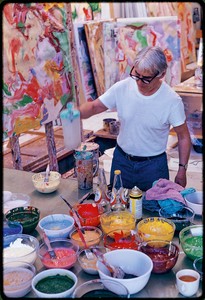
In tandem with the 60th Biennale di Venezia, the city’s Gallerie dell’Accademia is featuring the exhibition Willem de Kooning and Italy, an in-depth examination of the artist’s time in Italy and of the influence of that experience on his work. On September 20 of last year, the curators of the exhibition, the American Gary Garrels and the Italian Mario Codognato, engaged in a lengthy conversation about the exhibition for a press conference at the museum. An edited transcript of that conversation is published below for the first time.
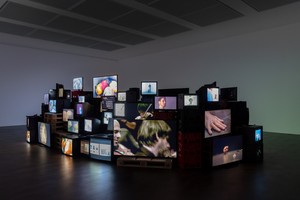
On the occasion of Douglas Gordon: All I need is a little bit of everything, an exhibition in London, curator Adam Szymczyk recounts his experiences with Gordon’s work across nearly three decades, noting the continuities and evolutions.
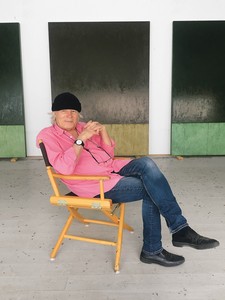
Larry Gagosian celebrates the unmatched life and legacy of Brice Marden.
In celebration of the centenary of Roy Lichtenstein’s birth, Irving Blum and Dorothy Lichtenstein sat down to discuss the artist’s life and legacy, and the exhibition Lichtenstein Remembered curated by Blum at Gagosian, New York.
Douglas Gordon took over the Piccadilly Lights advertising screen in London’s Piccadilly Circus, as well as a global network of screens in cities including Berlin, Melbourne, Milan, New York, and Seoul, nightly for three minutes at 20:22 (8:22pm) throughout December 2022, with his new film, if when why what (2018–22). The project was presented by the Cultural Institute of Radical Contemporary Art (CIRCA) in conjunction with the exhibition Douglas Gordon: Neon Ark at Gagosian, Davies Street, London.
Gagosian and the Art Students League of New York hosted a conversation on Roy Lichtenstein with Daniel Belasco, executive director of the Al Held Foundation, and Scott Rothkopf, senior deputy director and chief curator of the Whitney Museum of American Art, New York. Organized in celebration of the centenary of the artist’s birth and moderated by Alison McDonald, chief creative officer at Gagosian, the discussion highlights multiple perspectives on Lichtenstein’s decades-long career, during which he helped originate the Pop art movement. The talk coincides with Lichtenstein Remembered, curated by Irving Blum and on view at Gagosian, New York, through October 21.
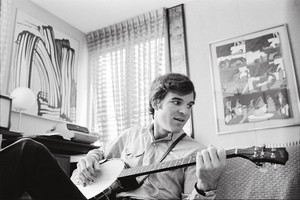
Actor and art collector Steve Martin reflects on the friendship and professional partnership between Roy Lichtenstein and art dealer Irving Blum.
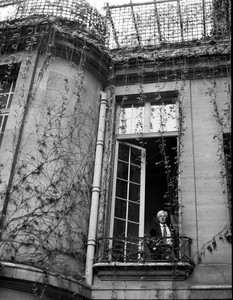
Andy Warhol’s Insiders at the Gagosian Shop in London’s historic Burlington Arcade is a group exhibition and shop takeover that feature works by Warhol and portraits of the artist by friends and collaborators including photographers Ronnie Cutrone, Michael Halsband, Christopher Makos, and Billy Name. To celebrate the occasion, Makos met with Gagosian director Jessica Beck to speak about his friendship with Warhol and the joy of the unexpected.
In this video, Jessica Beck, director at Gagosian, Beverly Hills, sits down to discuss the three early paintings by Andy Warhol from 1963 featured in the exhibition Andy Warhol: Silver Screen, at Gagosian in Paris.
Richard Wright and Martin Clark, director of Camden Art Centre, London, discuss Wright’s latest body of work, recent commissions, and new monograph, which provides a comprehensive overview of his practice between 2010 and 2020.
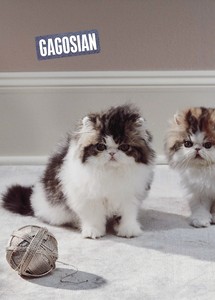
The Spring 2023 issue of Gagosian Quarterly is now available, featuring Roe Ethridge’s Two Kittens with Yarn Ball (2017–22) on its cover.
In conjunction with his exhibitions Adam McEwen at Gagosian in London, and Adam McEwen: XXIII at Gagosian in Rome, the artist sits down with author Ian Penman to discuss his new obituary works and graphite sculptures.
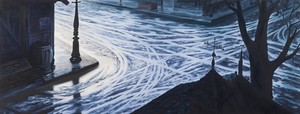
In this interview, curator and artist K.O. Nnamdie speaks with artist Dan Colen about his recent show in New York: Lover, Lover, Lover. Colen delves into the concept of “home” as it relates to his work, specifically the Mother and Woodworker series. Thinking through the political and historical implications of “homeland” in the context of the artist’s relationship with Israel and America, the two consider the intersections between these paintings—the final group of his Disney-inspired canvases—and Colen’s work with Sky High Farm, New York.

In an excerpt from his forthcoming monograph, Richard Wright pens a personal and philosophical text about painting.

Contemporary artists Adam McEwen and Jeremy Deller met up online over the holiday season to discuss McEwen’s upcoming exhibitions in London and Rome. McEwen delves into the motivations and criteria behind his work, as well as the challenges and complexities of memorializing the living.

The Winter 2022 issue of Gagosian Quarterly is now available, featuring Anna Weyant’s Two Eileens (2022) on its cover.
In this video, Deana Haggag, program officer, Arts and Culture at Mellon Foundation; Dan Colen, artist and founder of Sky High Farm; Linda Goode Bryant, artist and founder of Project EATS; and Diya Vij, curator at Creative Time sit down together to explore the roles of artist and audience, place and accessibility, legacy, capital influence, and individual vs. collective agency as they relate to artmaking today.
In this video, Thelma Golden, chief curator and director of the Studio Museum in Harlem; Tremaine Emory, founder of Denim Tears and creative director of Supreme; Father Mike Lopez, founder of the Hungry Monk Rescue Truck; and artist Anicka Yi sit down to explore how the concept of community has shaped their work, and the power in seeing the places we live, our histories, and even our bodies as porous, interdependent, and alive.